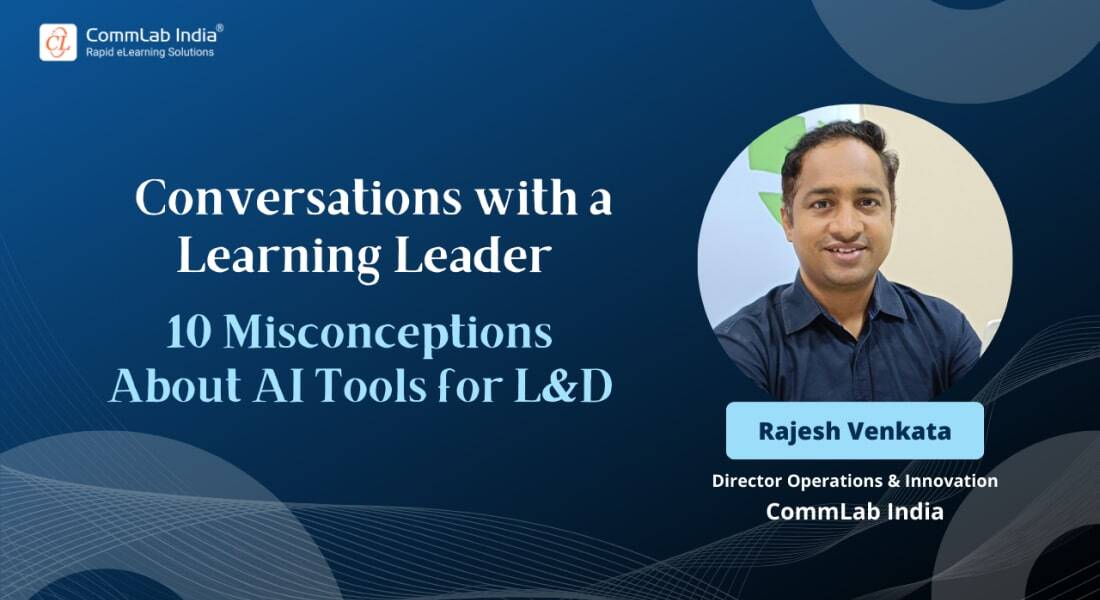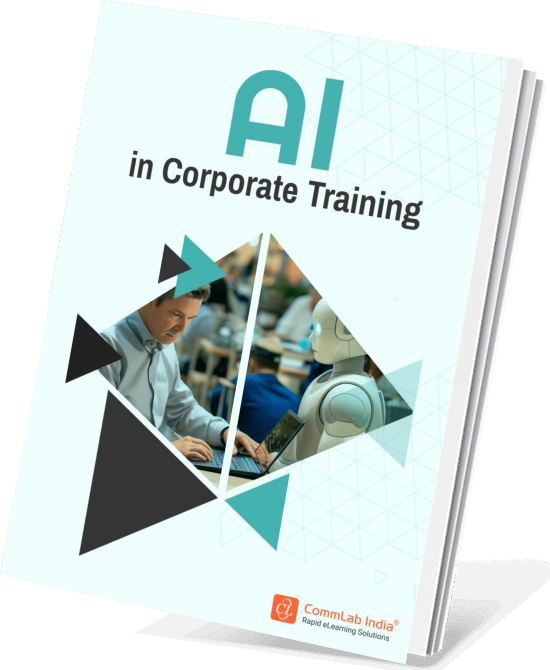10 Misconceptions About AI Tools for L&D — Podcast Excerpt

In today’s rapidly evolving tech landscape, many organizations still hesitate to fully embrace Artificial Intelligence (AI), often held back by misconceptions. In our latest CommLab India’s eLearning Champion podcast, we interviewed Rajesh Venkata, MCA, Director of Operations & Innovation at CommLab India, who brings project management skills and AI tools expertise to the table.
→ Download eBook: AI in Corporate Training
Join us as he tackles the most prevalent myths surrounding AI, shedding light on how this transformative technology can drive innovation and efficiency. This engaging discussion promises to equip you with the insights needed to navigate the complexities of AI and unlock its full potential in your organization. Don’t miss this chance to rethink what you know about AI!
Tune in to the podcast for an engaging myth-busting adventure.
Here’s a brief paraphrase of the interview.
What are the Common Misconceptions About AI Tools for Learning and Development(L&D)?
AI has become a pivotal tool in the realm of L&D, offering innovative solutions to enhance learning experiences and operational efficiency. However, as with any emerging technology, there are several misconceptions that often cloud its understanding and application. These misconceptions can lead to hesitancy in adoption or misuse, ultimately affecting the potential benefits that AI can deliver.
It's essential to address these misconceptions head-on to make informed decisions about integrating AI into L&D strategies.
Misconception 1: AI Replaces Human Professionals
There's a common fear that AI will take over jobs, leaving human professionals in the dust. In the realm of L&D, however, AI is more of a super assistant than a replacement. It handles repetitive tasks like content creation and assessments, allowing L&D experts to focus on what they do best: crafting engaging, strategic learning experiences and providing valuable human interaction and training. Far from taking jobs, AI complements human skills, enhancing productivity and creativity.
Misconception 2: AI in Learning is all about Gamification and Badges
Many people think AI in learning is just about adding badges and gamification to make things more exciting. But AI’s capabilities extend far beyond these superficial elements. It can personalize learning paths, suggest relevant content, and offer adaptive feedback tailored to individual needs. This means AI can transform learning experiences in a more profound and effective way than merely gamifying them.
Misconception 3: AI is Only Suitable for Technical Skills and Can’t Handle Soft Skills
It’s a myth that AI is only good for technical training. In reality, AI can effectively teach a wide range of skills, including soft skills like communication, teamwork, leadership, and critical thinking. The trick lies in selecting the right AI tools and methodologies suited for these varied learning objectives. With the right approach, AI can be as effective in developing soft skills as it is in technical training.
Misconception 4: So Many Options, It’s Overwhelming to Choose an AI Tool
With a myriad of AI tools and technologies available, choosing the right one can feel daunting. The best approach is to avoid the temptation to follow trends blindly. Instead, critically assess your training program’s unique needs, budget, and objectives. Conduct thorough research, compare options, and consider piloting different tools on a smaller scale before committing to a large-scale implementation.

Misconception 5: AI Risks Security and Reliability
Concerns about AI’s security and reliability are valid but often exaggerated. Leading AI vendors prioritize data protection and adhere to strict regulations, employing advanced security measures to safeguard learner information. Additionally, AI tools are frequently updated and improved, enhancing their reliability. The key is to thoroughly vet AI tools for security and reliability before integrating them into your learning systems.
Misconception 6: AI Learning is One-Directional or Passive
Some believe AI in learning is a one-way street, offering a passive experience. In reality, AI can facilitate active learning through simulations, interactive activities, and personalized feedback loops. Learners can engage with content, ask questions, and receive guidance, making the learning experience dynamic and interactive rather than passive.

Understanding AI in Corporate Training
Revolutionize Your Training with Next-Level Learning
- How AI enhances existing training programs
- AI toolkit for design and development
- Challenges to Consider with AI Implementation
- And More!
Misconception 7: AI Can’t Handle Complex Learning Needs
Another misconception is that AI struggles with complex learning needs. While basic tools may have limitations, advanced AI systems can tackle complex tasks such as personalized learning, adaptive learning paths, and content creation based on learner data. Think of AI as a powerful learning assistant capable of handling intricate training challenges.
Misconception 8: AI is all about Technology, Not Good Training
Some argue that AI focuses solely on technology, neglecting sound training principles. However, AI-powered learning should be rooted in solid pedagogical foundations. It can assist in designing personalized learning paths, recommending relevant content, and providing adaptive feedback, all while aligning with training best practices. AI enhances the learning process, but effective training strategies are still crucial.
Misconception 9: AI in L&D is Just a Buzzword
There’s a belief that AI is merely a trendy buzzword with little real impact. In contrast, the growing adoption and continuous development of AI tools in L&D showcase their transformative potential. The tangible benefits we’re witnessing indicate that AI is not just a fleeting trend but a significant force reshaping the learning landscape.
Misconception 10: Implementing AI in L&D is a One-Time Project
Implementing AI isn’t a set-it-and-forget-it endeavor. AI tools generate valuable data on learner behavior and program effectiveness, which should be continuously analyzed to fine-tune approaches and adjust learning paths. Staying engaged with the latest advancements and maintaining a growth mindset is essential for maximizing AI’s potential in L&D.

The Path Ahead
By dispelling these misconceptions, L&D professionals can unlock the full potential of AI tools to enhance their learning initiatives. As organizations begin to appreciate the supportive role of AI, they'll find themselves better positioned to drive learning success, creating a workforce that is adaptable, skilled, and ready for future challenges.
Are you ready to revolutionize your corporate training strategy? Dive into our comprehensive eBook to discover how L&D professionals are at the forefront of training transformation. This essential read explores how AI-powered reskilling can bridge skill gaps, ensuring your workforce is equipped with the tools they need for success. Uncover practical AI applications in design, development, and more.





